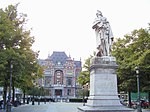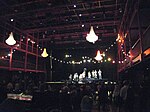Office Baroque
Office Baroque is a Belgian contemporary art gallery situated in Antwerp. The gallery was originally incorporated in 2007 in an apartment on Harmoniestraat in Antwerp by Marie Denkens and Wim Peeters. The gallery has occupied a location on Lange Kievitstraat in Antwerp from 2008 till 2013. It opened its first gallery in Brussels on 7 November 2013 with an exhibition by French/American artist Michel Auder in a 1909 cast-iron building by the Brussels architect Paul Hamesse who was part of the Art Nouveau generation. In September 2015, Office Baroque opened a second gallery space in the vicinity of the Centre for Fine Arts, Brussels. In September 2020 the gallery relocated to its original space on Harmoniestraat in Antwerp. The gallery is named after one of Gordon Matta-Clark’s public interventions, untimely demolished after extensive protests in Antwerp in 1980. The gallery represents American, Asian and European artists and has produced exhibitions and publications. Office Baroque presents exhibitions at international art fairs such as Frieze Art Fair, London; FIAC, Paris; Art Basel, Miami Beach; Independent, New York.
Excerpt from the Wikipedia article Office Baroque (License: CC BY-SA 3.0, Authors).Office Baroque
Place du Jardin aux Fleurs - Bloemenhofplein, City of Brussels Pentagon (Brussels)
Geographical coordinates (GPS) Address Nearby Places Show on map
Geographical coordinates (GPS)
| Latitude | Longitude |
|---|---|
| N 50.848406 ° | E 4.343225 ° |
Address
Place du Jardin aux Fleurs - Bloemenhofplein 5
1000 City of Brussels, Pentagon (Brussels)
Belgium
Open on Google Maps









